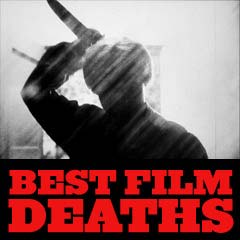
|
Deaths Scenes 1976 |


|
Carrie (1976) Director Brian DePalma's horror film was based upon a Stephen King novel (it was the first of King's published works to be adapted into a feature film). The title character - telekinetic Carrie White (Sissy Spacek) - with uncontrollable rage and revenge - murdered her fellow high school prom-goers (shown in split-screen) after being cruelly doused with a bucket of pig's blood from above. In her mind, she heard tauntings: "They're gonna laugh at you," and "Plug it up!", and in her view (spinning around), she imagined the prom-goers jeering at her. Seeking retribution, she caused the prom's exit doors to slam shut, and the lights to pop. An emergency fire hose snaked into mid-air and doused the party-goers, causing chaos, confusion, and bodies careening around the dance floor. Some were electrocuted (Mr. Fromm (Sydney Lassick)), crushed by falling rafters (Miss Collins (Betty Buckley)), trampled, or burned to death in the resulting fire. Outside as Carrie walked home, she overturned a car attempting to hit her, driven by Billy Nolan (John Travolta) and Chris Hargensen (Nancy Allen), and she caused the flipped, rolled-over car to burst into flames.
|
    The Bucket of Pig's Blood and Psychic Revenge |
||||||||||||

|
Carrie (1976) Psychokinetic Carrie's (Sissy Spacek) ultra-religious psychotic mother Margaret White (Piper Laurie) was attempting to kill her daughter, after the ruinous prom experience. Carrie had removed her blood-stained clothes and bathed in a tub. Then, she wished for comfort from her mother (who appeared from behind the bathroom door). She asked to be hugged:
Instead, as they knelt together, Mrs. White was self-critical about when she had conceived Carrie in a moment of sinful weakness and mistakenly carried her to term:
Suddenly, as she was reciting the Lord's Prayer, Mrs. White reached for a gleaming butcher knife and stabbed Carrie in the back as she was hugging her. The struggle traveled to the first floor, where Carrie had tumbled. Cornered in the locked kitchen, a fatal blow was about to be delivered by the raised knife. To stop the assault, Carrie used her telekinetic powers to send a projectile of another sharp knife to pin her mother's right hand against a wooden kitchen door pillar. Other kitchen objects (a peeler, another knife, and other cutlery and utensils) further pinned her mother's left hand (on the other side of the entryway) and also wounded her in the chest. One final knife spun into her mother's heart as the ultimate death blow. The image was of her suffering mother literally being crucified with her hands pinned to the sides. She gasped in almost religious pain and ecstasy, and then her head flopped to the side, with a slight martyred smile (as the camera slowly pulled back).
Carrie pulled her mother off the kitchen door-frame, causing the house to creak and crumble, and the two were in the prayer closet as the house burned down around them. It literally sank and was swallowed into the ground. The Jesus effigy image in the closet had arrows in its chest, duplicating the position of the sharp objects embedded in Mrs. White body. Both perished in the blaze. |
 Stabbed in the Back    Crucifying Her Mother   Carrie In the Closet With a Jesus Effigy - Perishing in Blaze and Collapsing House |
||||||||||||

|
The Front (1976) Director Martin Ritt's black comedy told about the era of blacklisting of suspected Hollywood writers/directors who were thought to have Communist ties by right-wing McCarthyites in the early 1950s. It was the first commercial Hollywood film to directly tackle the controversial subject. Its tagline was:
Small-time bookie, semi-illiterate and restaurant cashier Howard Prince (Woody Allen), with left leaning tendencies and few political convictions, was not contaminated by the blacklisting that was sweeping the country. He was asked to sign his name - acting as a "front" - to TV scripts that were written by other blacklisted screenwriters. It was beneficial for him, because he would receive a 10% commission (to help pay off his gambling debts). Weekly TV game show host Hecky Brown (Zero Mostel) (née Herschel Brownstein) was one of those blacklisted in the industry because he once marched in a May Day parade. Troubled and despairing about losing his TV comedy job and having his salary cut, the blacklisted actor was given a terrible choice by the HUAC (the House Un-American Activities Committee) - to continue working, he had to consent to spy (and rat) on his new friend Howard Prince. The humiliated, despairing and resigned actor chose to commit a heartbreaking, planned suicide in a hotel room by jumping from the window. He entered a posh NYC hotel room on a high floor, where he overtipped both the bellboy and the waiter who brought a chilled bottle of champagne that he had ordered. He drank a bit from a fancy champagne glass, silently toasted himself in a mirror by gulping directly from the bottle, and then walked off-camera to the right (his reflection disappeared). The sound of a window opening and the sight of curtains fluttering in the breeze (with the bottle left on the inside ledge) at the open window implied that he had jumped to his death. In the film's conclusion, Howard saw the injustice around him after Hecky's death and testified before the HUAC, and ultimately defied their questioning - to become "America's most unlikely hero." [Note: During the end credits, six of the actors or crew, including Zero Mostel, were listed as being blacklisted in the early 1950's. Actor Phillip Loeb, a friend of Mostel's, was blacklisted in the early 1950s and committed suicide with an overdose of sleeping pills in a hotel room. Hecky's character in the film was loosely based upon Loeb.] |
   Hecky Brown (Zero Mostel) 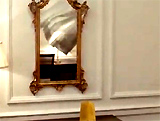  An Open Window Following the Suicide |
||||||||||||
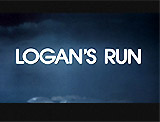
|
Logan's Run (1976) Michael Anderson's sci-fi action-adventure presented a dystopic view of society in the year 2274, in which inhabitants lived a life of hedonism and pleasure in a domed city (run by a female-voiced super computer). At the age of 30, citizens had to submit to either "renewal" (a peaceful death) or "Carousel" (a gladiatorial battle) - otherwise, they faced having to become a "Runner" to escape. Each inhabitant received a signal to attend a renewal Carousel ceremony, when reaching the age of 30. A "life-clock" crystal embedded at birth in the left hand's palm, would change color and blink red - to signal the "Last Day." Everyone was told that they would be renewed and reborn at the "Carousel" ceremony (attended by an audience cheering "Renewal" in a round amphitheatre), where the white robed participants floated up into the air toward a huge suspended gem - and exploded in a shower of sparks. The film's twist was that the quasi-religious ritual was actually a death ceremony (the participants were zapped like bugs). |
   The "Carousel" Rebirth Ceremony  Floating, Explosive Deaths |
||||||||||||

|
Director Sidney Lumet's award-winning drama was a brilliant, pitch-black criticism of television journalism. In the final shocking scene, after The Howard Beale Show segment was introduced, the news anchor Howard Beale (Peter Finch) was gunned down by two revolutionary radicals (one was an uncredited Tim Robbins in his film debut) in the audience. The assassins had been hired by the network to do away with him. Beale pitched backwards from the impact of multiple bullet wounds (in the forehead and chest) - bloodied. The cameraman would only cover the shot for television and not assist. Jack Snowden, a newsman substituting for Howard Beale, was displayed on one of four monitors on a bank of TV screens as he delivered the breaking news story. Snowden's words were dwarfed by simultaneously running commercials (including Canada Dry's Bitter Lemon drink ("We never compromise, so why should you? Canada Dry Mixers. Why compromise?"), and the famous Life cereal commercial ("Let's get Mikey to try it. He won't eat it. He hates everything...He likes it! He likes it!")):
The narrator added a final epitaph:
|
   The Assassination of Howard Beale  Bank of Four Monitors |
||||||||||||

|
The Omen (1976) Director Richard Donner's classic supernatural horror film of demonic possession was the first part of a trilogy, followed by Damien: Omen II (1978), and The Final Conflict (1981) (aka Omen III), and a remake in 2006. During Damien's (Harvey Stephens) outdoor birthday party, the 5 year-old boy's nanny (Holly Palance) stared at a black dog. A few moments later, she had entered into the English mansion's attic, tied a noose around her neck, stood out on the ledge of the window, and then jumped and suicidally hanged herself after calling out her final words to Damien and the party guests:
Her swinging body crashed into the second floor window behind her. Terrified mother Katherine Thorn (Lee Remick) held Damien in her arms and shielded him from the horror - but he seemed pleased - he waved at the Rottweiler (a protective Hellhound). During a freak storm outside a church after providing severe warnings to Robert Thorn (Gregory Peck) in Bishop's Park about his endangered family, and instructions to kill their child Damien, Father Brennan (Patrick G. Troughton) died in a "bizarre tragedy" - he was impaled by a heavy steel rod that was struck by lightning, broke off, sailed through the air (like a javelin throw) and skewered him into the ground. Thorn's pregnant wife Katherine was having ominous fantasies described by a therapist ("She fantasizes that your child is alien and that your child is evil"). Her fears were justified - Damien maniacally pedaled his red and white tricycle and knocked his mother over the second-floor stairway railing to the menacing sound of ''Ave Satani", causing her to fall, miscarry, and suffer "a concussion and a broken humerus, and, well, some internal bleeding." Later while recuperating, she was able to tell her husband: "Don't let him kill me." Much later in the film, hapless photographer Jennings (David Warner) had just vowed to father Robert Thorn that he was going to stab his evil son Damien with the seven mystical daggers ("If you don't do it, I will"). But then he was decapitated during a freakish accident, when a truck lost its brakes. Parked on a slight incline, it gathered speed as it went out of control. A sheet of plate glass flew off the open flat-bed of the truck and sliced cleanly through his neck. It sent his spinning body-less head flying through the air. It ended up resting on the ground where it could view itself in reflected glass. In the film's conclusion, Thorn cut off some of Damien's hair to locate the "666" marking on his scalp. He then fought off Mrs. Baylock ("an apostate of Hell") and stabbed her with both a carving fork and screwdriver in the neck. Bloodied himself, he dragged his screaming son away to a nearby church altar to sacrifice him with the seven mystical daggers from Megiddo (a derivative of the word "Armageddon" and the site of an archaeological dig outside Jerusalem). Thorn was shot to death by police as he raised his hand with the first dagger. At the double-Thorn funeral at Arlington National Cemetery attended by the US President (off-screen), Robert's brother, it appeared that he had adopted Damien - the devil-child stood next to him during the ceremony, and then turned back to look at the camera while smiling, as the film ended.
|
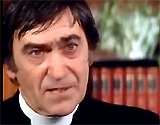 Father Brennan's Warning to Thorn 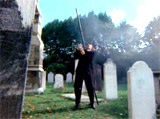 Brennan Skewered by a Steel Rod  Murder of Katherine Thorn by Mrs. Baylock 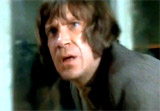   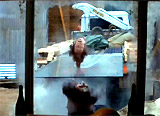 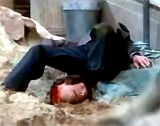 Photographer Jennings' Head Decapitation  Murder of Mrs. Baylock |
||||||||||||

|
Snuff (1976, Arg./US) At the end of this exploitation film (marketed as a snuff film although it wasn't) was a brief, tacked-on 5 minute coda or epilogue (a film within a film). It was the film's most outrageous footage of all - an added "snuff murder" that involved the disemboweling of a female cast or crew member by another cast member (or the director?) after major filming ended. In the film's cinema verite coda or epilogue (a film within a film), the camera pulled back to reveal the set of the film during its making - the bedroom where the murders (for the major portion of the film) had just been shot. Following filming, one of the cast members (or the 'director'), who was wearing a blue T-shirt proclaiming: "Vida Es Muerte," began making out with a blonde female (another cast or crew member?). Then, he suddenly and surprisingly straddled her, held her down (with help from another smiling female named June), and cut into her left shoulder with a large-bladed knife. When she squirmed and screamed loudly, he cut off a few of her left hand's fingers (including her ring finger) with scissors. Another male helped him to cut off her entire right hand with a jigsaw.
As the crew kept filming, he used the knife to disembowel her (he reached inside the opening), after which he held up her bloody intestinal entrails or viscera, and screamed triumphantly. Then, the camera appeared to run out of film as the screen turned white (and then black), and two male crew members were heard speaking to each other:
The film ended abruptly. |
    Mutilation of Victim |
||||||||||||
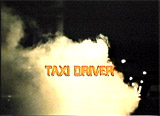
|
Director Martin Scorsese's gritty urban drama explored the psychological madness within an obsessed, twisted, inarticulate, lonely, anti-hero cab driver and war vet. The bloody shootout at the film's conclusion involved many grisly murders, mostly committed by one-man vigilante taxi driver Travis Bickle (Robert DeNiro). In a shocking, cold-blooded act, Travis wreaked vengeance on young Iris' (Jody Foster) abductor - he stuck a gun point-blank into pimp Sport's (Harvey Keitel) gut and pulled the trigger, seriously wounding him in the stomach after threatening: "Suck on this." A few moments after shooting Sport in the gut, Travis entered the darkened stairway leading to Iris' apartment where he approached the bouncer-manager-pimp of the hotel rooms (used as a brothel). In another gory scene of incredible orgiastic violence and cold-blooded slaughter, partially filmed in slow-motion, he shot and blew off part of the bouncer's/pimp's right hand. The blast splattered blood and caused echoes throughout the corridors. Then, Travis was shot from behind by Sport (who had followed him), and wounded on the left side of his neck. Bleeding profusely, Travis turned to look behind him where he saw Sport with a firearm, and he gunned him down at the end of the corridor. Then, Travis was shot in the right shoulder-arm by a Mafioso (Bob Maroff) (one of Sport's gangster associates and Iris' customer) - he retaliated by killing the gangster by filling his face and body full of bullets, causing him to fall backwards into Iris' room. Still alive, the wounded bouncer/pimp crashed atop Travis and wrestled him to the ground - they thrashed around into Iris' apartment where Iris was shrieking and frozen in fear. Travis pulled his combat knife from his boot and impaled the bouncer's/pimp's left hand. He reached over and picked up the revolver from the now-dead Mafioso on the floor and shot the assailant point-blank in the cheek - brains were splattered onto the wall. With two different guns, Travis attempted to shoot himself in the neck, but the guns clicked empty. Exhausted and struggling, he simply collapsed onto the red velvet sofa next to a fear-stricken Iris. His head slowly dropped back amidst the bloodbath. When the police arrived with guns drawn, Travis was unable to speak. In a gruesome closeup, he helplessly raised a blood-soaked, dripping finger to his head and made explosive sounds with his mouth as he mimicked pulling the trigger three times in a mock-suicide: "Pgghew! Pgghew! Pgghew!" At the end, Travis wished to sacrifice himself as the ultimate act of fulfillment, cleansing, and purification, but his suicide attempt failed. He slowly lost consciousness from massive blood loss, and his head fell backward. The scene ended with an overhead tracking shot in which the camera slowly panned over the bloody trail of carnage in the room and down the stairs to the outer door. [Note: The entire brothel shoot-out massacre was displayed with desaturated color (the blood looked brownish red instead of bright red), in order to secure an R-rating for the film.] |
 Shooting Sport in the Abdomen  Shooting Off Right Hand of Bouncer/Manager/Pimp  Killing of Sport  Murder of Mafioso Gangster/Customer  Murder of Bouncer/Pimp  Travis' Attempts to Kill Himself Failed |
||||||||||||
(chronological by film title) Intro | 1915-1929 | 1930-1933 | 1934-1938 | 1939 | 1940-1942 | 1943-1945 | 1946-1947 | 1948-1949 1950-1952 | 1953-1955 | 1956-1957 | 1958-1959 1960-1961 | 1962-1963 | 1964-1966 | 1967-1968 | 1969-1970 1971 | 1972 | 1973 | 1974 | 1975 | 1976 | 1977-1978 | 1979 1980 | 1981 | 1982 | 1983 | 1984 | 1985 | 1986 | 1987 | 1987 | 1988 | 1989 1990 | 1991 | 1992 | 1993 | 1994 | 1994 | 1995 | 1995 | 1996 | 1997 | 1998 | 1998 | 1999 2000-2001 | 2002 | 2003 | 2004 | 2005 | 2006 | 2007 | 2008 | 2009 | 2010 | 2011 |